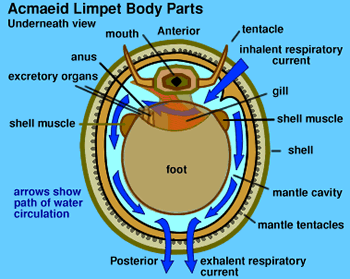|
|
Molluscs - Limpets
![]() Limpets
are distinctive animals which are best known for their ability to cling
onto rocks. They do not have suction, but their strong muscular foot can
grab small imperfections in the rock surface, and grasp very strongly.
This limpet is the Variegated Limpet
Cellana tramoserica.
Limpets
are distinctive animals which are best known for their ability to cling
onto rocks. They do not have suction, but their strong muscular foot can
grab small imperfections in the rock surface, and grasp very strongly.
This limpet is the Variegated Limpet
Cellana tramoserica.
Limpets have a distinctive, oval shaped shell, with the peak more-or-less near the centre, although there are a few interesting exceptions.
![]() When
the tide is high, the limpets move about grazing on algae. As the tide
drops, they usually return to their resting place. This homing behaviour
is evident by looking at distinctive scars. Some limpets have been able
to find their "home" when relocated as far as a metre away. This limpet
is Petterd's Limpet Notoacmea
petterdi.
When
the tide is high, the limpets move about grazing on algae. As the tide
drops, they usually return to their resting place. This homing behaviour
is evident by looking at distinctive scars. Some limpets have been able
to find their "home" when relocated as far as a metre away. This limpet
is Petterd's Limpet Notoacmea
petterdi.
Many limpets, such as the Acmaea Limpets of which Petterd's Limpet is one, have lost their second gill, and the one single gill projects to the right side of the body.
In all true limpets the mantle has developed a considerable overhang, so that there is a groove which runs around the inside of the shell called the Mantle Groove. It is through these two grooves that the water current flows.

The incoming water, called inhalant respiratory current, enters the mantle cavity near the front (anterior) on the left side, as viewed from above.
Part of the current flows down the left side, but more importantly , the rest of the current flows over the gill followed by the excretory organs and the anus, and then down the right mantle groove.
The two streams of water converge at the rear (posterior) of the Acmaeid Limpet behind the foot and leave the body and flows out from under the shell.
Question:
What are the advantages of this design ?
Hint:
- What is the incoming water carrying ?
- What is the outgoing water carrying ?
Identification:
The problem with limpets is that a number of unrelated marine gastropods have evolved limpet-shaped shells, and this can make identification difficult. There are a whole group of false limpets, many of which are unrelated. There are the Siphon Shells and there are other limpet-like molluscs with a similar body shape.
Question:
Why is this body shape so common ?
To make matters worse, environmental conditions can also affect size, shape, ornamentation and colour, so that members of a single species may look quite different to one another.
| For more information on Molluscs visit MESA Molluscs |
Variegated
Limpet
Petterd's Limpet
Home
Page
Taxonomy
Biogeography
Rocky Shores
Tidal Levels
Intertidal Zonation
Environmental Factors
Biological
Factors
Feeding Relationships
Activities
Glossary
References
 Life
on Australian Seashores
Life
on Australian Seashores
by Keith Davey (C) 2000
Learning Consultant
- Media
The University of Newcastle
email at australian_seashores@hotmail.com
Scientific Consultant: Phil
Colman
site created 01.01.98 : updated 01.04.2000
